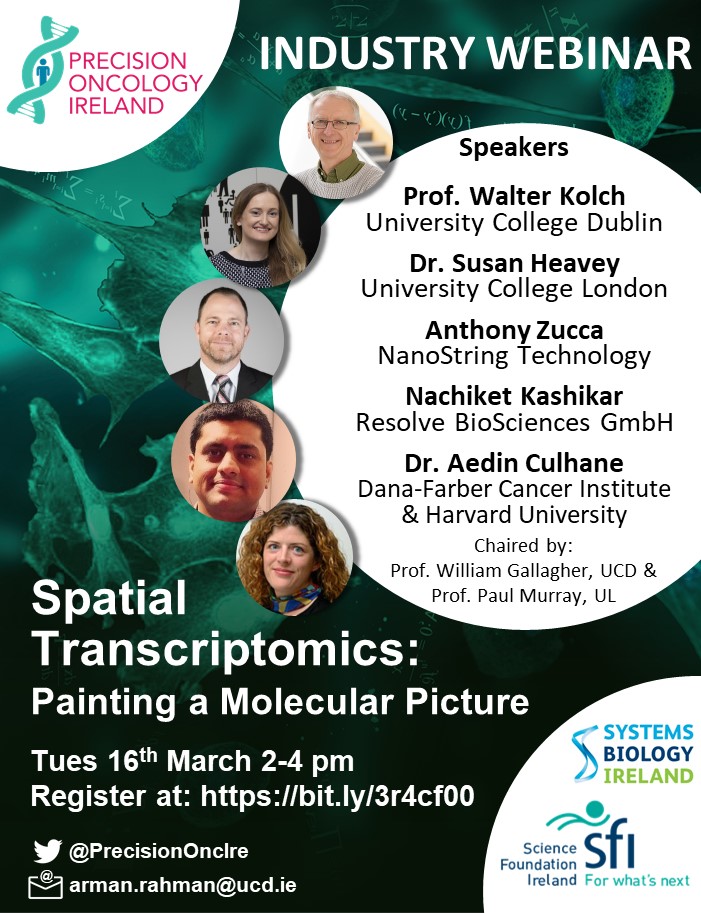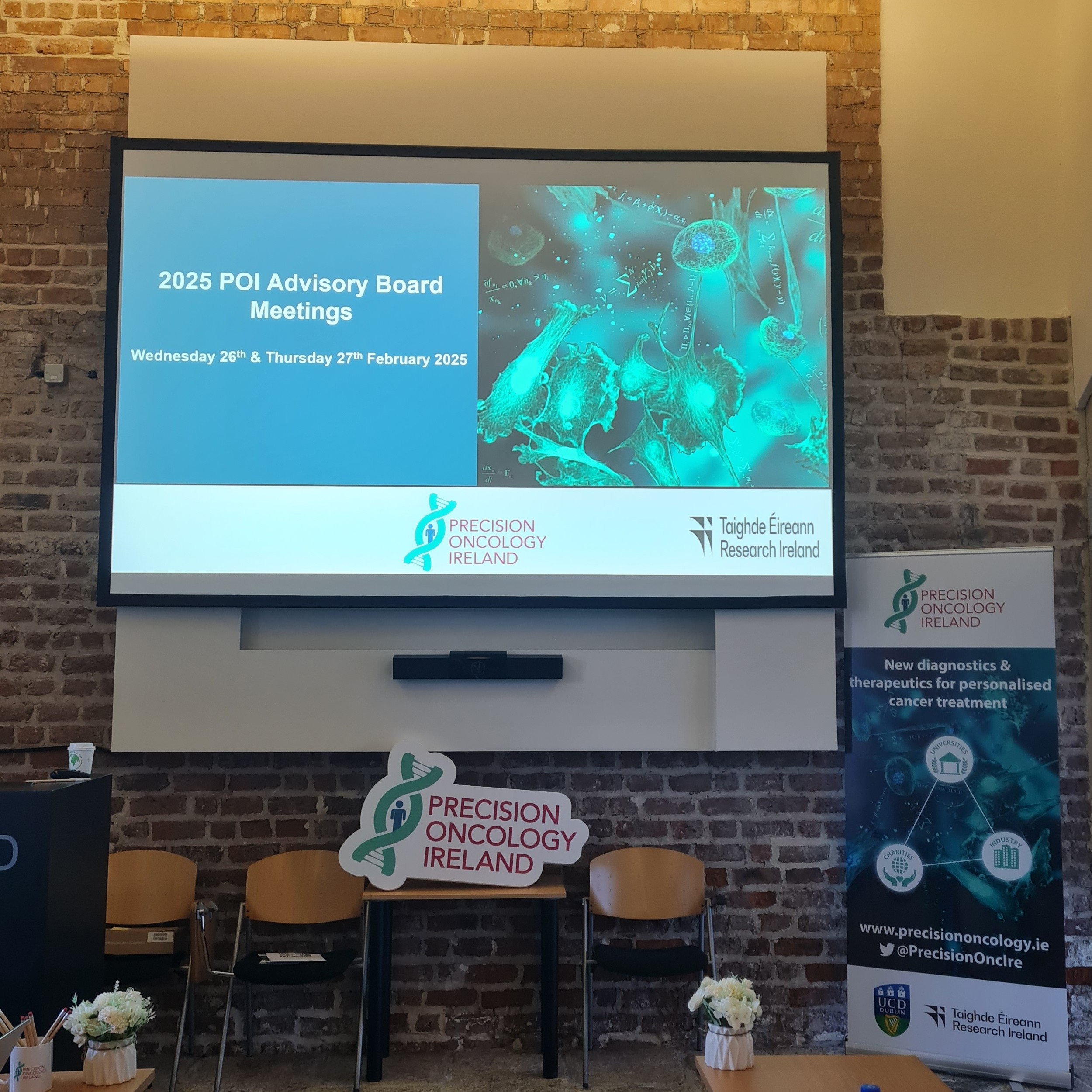POI Industry webinar ''Spatial Transcriptomics: Painting a Molecular Picture'
Published 30th March 2021
Precision Oncology Ireland hosted an Industry Webinar entitled 'Spatial Transcriptomics: Painting a Molecular Picture' on Tuesday the 16th of March from 2 - 4pm GMT via Zoom. Understanding the cellular and molecular heterogeneity of tumour tissues continues to be a challenge for high-throughput molecular profiling technologies. Spatial transcriptomics can provide the molecular identity of complex tissues consisting of various cell types. This mini-symposium offered an overview and update of the field by academic and industry leaders.
A recording of the event can be viewed here (viewing registration is required).
Dr. Susan Heavey's slides from the webinar are available to be downloaded here: Dr. Susan Heavey's slides
Anthony Zucca's slides from the webinar are available to be downloaded here: Anthony Zucca's slides
The webinar was chaired by Prof. William Gallagher, University College Dublin & Prof. Paul Murray, University of Limerick and we heard from the following speakers:
- Prof. Walter Kolch, University College Dublin
- Dr. Susan Heavey, University College London
- Anthony Zucca, NanoString Technology
- Nachiket Kashikar, Resolve BioSciences GmbH
- Dr. Aedin Culhane, Dana-Farber Cancer Institute & Harvard University
POI was delighted to have these speakers participating in the event. Below we have included further information on several of the event speakers and the topics that were discussed.
Walter Kolch
Prof. Walter Kolch is Director of Systems Biology Ireland and Precision Oncology Ireland. A leading international proponent of precision medicine, he is internationally recognised for his cutting-edge research using systems approaches to understand signalling networks and is ranked 2nd in the world in precision medicine, 6th in systems medicine, 23rd in signal transduction and 40th in proteomics (Google Scholar). His current interest is focusing on using computational modelling and omics approaches to analyse biological networks to elucidate the molecular mechanisms of cancer and other diseases in order to design new approaches to personalised diagnostics and treatment based on a systems level, molecular mechanistic understanding. Using mathematical and computational modelling to analyse the network structure of cell signalling, the aim is to predict responses to perturbations (such as drugs), define the most sensitive points for interference by drugs, and analyse the specificity of signalling and adaptation processes.
Susan Heavey
Prof. Susan Heavey a lecturer in translational medicine at University College London interested in use of 3D ex vivo models for drug development and personalised medicine and to predict treatment response in cancer. She uses an integrative approach to solve clinical research problems, prioritising multidisciplinary collaborations with robotic surgeons, radiologists, pathologists, bench and computational scientists. Prof. Heavey developed the MRI guided prostate cancer biobanking pathway PEOPLE, which has to date recruited over 200 cases for a range of downstream 3D model projects within UCL, nationally and internationally, as well as contributing 100 cases to Genomics England's 100,000 Genomes Project. Her current travelling fellowship is SCREEN, where she is using the ex vivo culture approach to compare emerging 2D/3D spatial genomics technologies, gaining training in cutting edge basic science as a visiting scientist in Cold Spring Harbour Laboratory, USA, as well as furthering her drug development projects within UCL.
Anthony Zucca
Anthony Zucca, a Technical Sales Specialist at NanoString Technologies, Inc and the title of his talk was ‘Morphology Driven High-Plex Spatial Analysis of Tissue Microenvironments’. NanoString is a global leader in spatial gene expression. With the launch of the GeoMx Digital Spatial Profiler (DSP) researchers now have the ability to view morphology of their tissue and define exactly where they want to detect changes in gene expression for whole transcriptome RNA or up to 100+ proteins. The GeoMx platform comfortably works with both FF or FFPE tissue in both human and mouse. This seminar highlighted the technology behind the GeoMx with a focus on various test cases to visualize high impact research applications.
Nachiket Kashikar
Nachiket Kashikar is the head of Business Development, Service, and Commercial Operations at Resolve. He will be discussing how in health and disease, it is essential not only to understand the molecular inventory of each cell in the microenvironment of a tissue but that too, in its full spatial glory. Nachiket will describe Resolve’s Molecular Cartography™ technology, a pioneering platform which produces deep contextual data sets that illuminate molecular interactions at subcellular resolution while preserving the sample tissue. Here, he will display the versatility of this technology across different cell culture and tissue systems together with key attributes such as sensitivity, exquisite resolution, specificity, and capability to combine with cell labelling or immunostaining. This interactive analysis software helps to project individual mRNA transcripts onto defined morphological structures and allow the user to work with cell-by-gene and gene-by-cell matrices. Molecular Cartography technology is available to researchers all over the world through Data-as-a-Service platform.
Aedin Culhane
Aedin Culhane, PhD, Department of Data Science at the Dana-Farber Cancer Institute, and Department of Biostatistics, Harvard TH Chan School of Public Health develops computational approaches to integrate and analyze large scale genomics data to study tumor immunology and the tumor microenvironment. Advances in single cell multi-omics technologies are creating tremendous new data resources and emerging atlases are revealing new fundamental cellular biology. When combined with spatial resolution cell-cell proximity data, hitherto unimageable in-depth analysis of cell communities and cell-cell cross talk can be performed. However, methods to integrate multi ‘omics single cell data and methods for spatial analysis of single cell ‘omics are only emerging. To address this community need, in the summer of 2020, she and Profs Fertig, LeCao co-chaired a 5-day hackathon workshop on Mathematical Frameworks for Integrative Analysis of Emerging Single-Cell Data (Banff International Research Station, 2020), in which experts in algorithm, development and matrix factorization compared approaches for the analyses and integration of single cell multiple ‘omics and spatial ‘omics data. They provided 3 hackathon multi ‘omics data integration challenges, two of which included spatial data. Aedin described these challenges, the methods applied and developments in Bioconductor for spatially resolved multi omics data integration and analysis, and how they are using these to elucidate the tumor-immune cell environment.


